Dhankar Fort Tour For A Timeless Journey Into Spiti’s Heritage In 2025
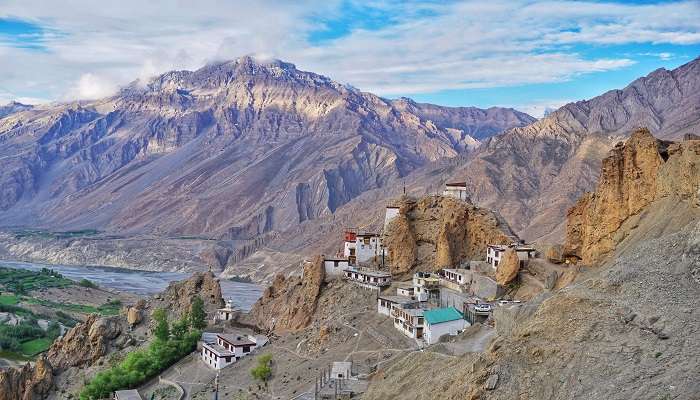
Dhankar Fort, built on a cliff overlooking the old Dhankar Monastery has become a symbol of architectural brilliance and the rich history of the Spiti Valley in Himachal Pradesh, India. Today, the fort lies in ruins but these ruins are a treasure trove of history besides providing great vantage to admire the Spiti valley. Dhankar Fort is listed among the 100 most endangered sites globally, and at the same time, the perspective that it offers to enjoy the beautiful scenery is worth a visit.
Best Time To Visit Dhankar Fort
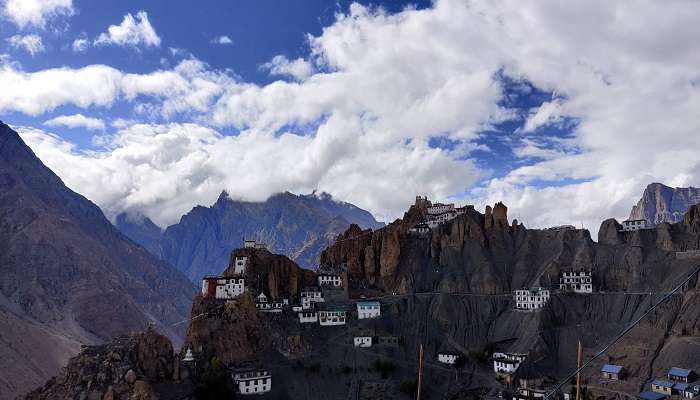
Summer (May to September):
The best season to visit Dhankar Fort is during the summer months, from May to September when the climate is pleasant and suitable for sightseeing. The weather is gentle, and the roads are navigable, thus increasing the ease of travelling. The temperature varies from 15 degrees Celsius to 25 degrees Celsius, which is appropriate for tours and trekking.
Monsoon (July to September):
Although the monsoon season results in some precipitation, the climate of this area is relatively dry, and thus the rains are not very intense. But, it is suggested to refer to the weather predictions before planning any tour as the landslides might hinder tours.
Winter (October to April):
The Spiti Valley experiences severely cold winters with temperatures that may sometimes drop below freezing point. Moderate to heavy snow can shut down the roadways, rendering Dhankar isolated. Nevertheless, if one loves snow, and particularly if one is winter-dressed, the sight of a fort covered with snow is a gorgeous one.
Must Read: 8 Days Spiti Valley trip
Historical Significance
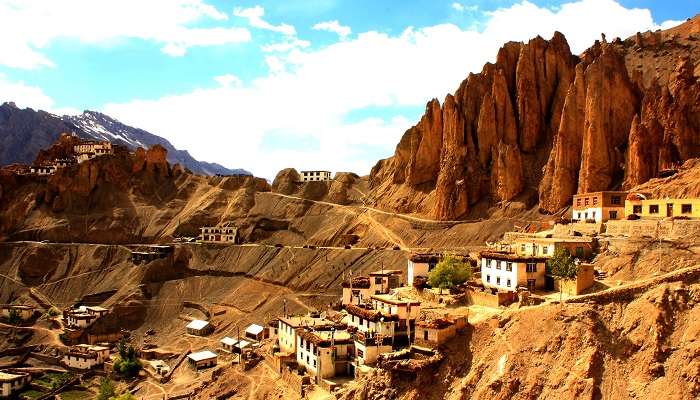
Ancient Stronghold:
The fort of Dhankar has a very rich history. It has existed since the twelfth century and was the capital of Spiti Valley up to that time. The fort’s construction was well intended to enable the observation of invasions or attacks. Due to its elevation and location on a hill, it was easy to defend and acted as a rather impenetrable fort.
Shelter in Times of War:
Sometimes during conflict, this fort offered shelter to the entire valley’s population. The layout of the fort provided concealed access and means of escape, as well as a concealed pantry and water supply, which enabled the occupants to survive famines.
Architectural Marvel:
The structure and designing of the fort is a combination of both the traditional Tibetan as well as the Buddhist architecture. With regard to the architectural style, one can state that the most commonly used materials for construction were mud and stone, and the decorative features included carvings and murals that relate to the culture of the region. Although not much has been left of the glory of the fort, some buildings still stand today.
Endangered Heritage:
Due to its deteriorating condition, the Dhankar Fort has even made the list of the 100 most endangered sites in the world. The fort’s situation and resultant natural erosion processes also question the feasibility of restoring it. Action Programs are being undertaken to maintain the fort’s dynamic stability and prevent it from turning into ruins.
Things To Do
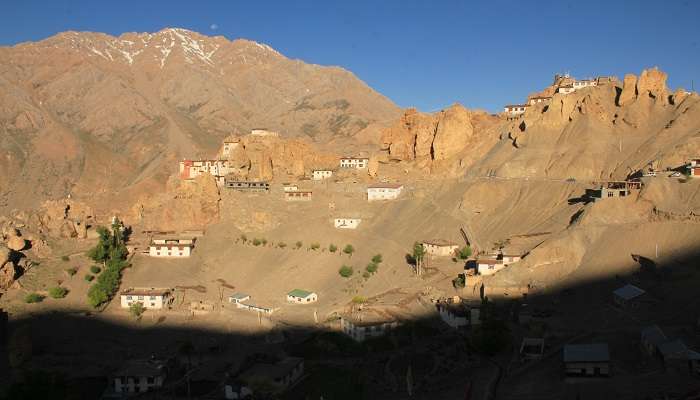
Roam around the ruins of Dhankar fort and experience history through the eyes of those who used to live inside it.
Explore the Fort Ruins:
Roam around the ruins of Dhankar fort and experience history through the eyes of those who used to live inside it. Most of the remaining structures of the fortification are watch towers, living spaces, and outside places that have some or other story to narrate.
Photography:
The views from Dhankar Fort are simply perfect for taking great nature photos. Capture the grandeur of the entire Spiti valley, the winding river of Spiti, and the faraway Himalayan ranges. This is really good for photographers since different times of the day bring different lighting values.
Visit Dhankar Monastery:
Only a little below the fort is the very old monastery of Dhankar. It is one of the oldest monasteries of the Spiti Valley. It contains a few old thangkas, which are Buddhist paintings of raw cotton or silk, and some valuable manuscripts and statues. The serene environment and its religious importance make it a must-visit place.
Hike to Dhankar Lake:
A tour to Dhankar Lake is a rather promising adventure that adrenaline junkies would find quite to their liking. The trend of the trail is moderate, and it takes 2- 3 hrs to get to the lake. The calm and clear water of the lake, which sits beside the towering mountains, is a perfect place to walk in a daze.
Suggested Read: Places To Visit In Spiti Valley
Other Attractions Around Dhankar
Dhankar Fort, built on a cliff overlooking the old Dhankar Monastery has become a symbol of architectural brilliance and the rich history of the Spiti Valley in Himachal Pradesh, India.
1. Tabo Monastery
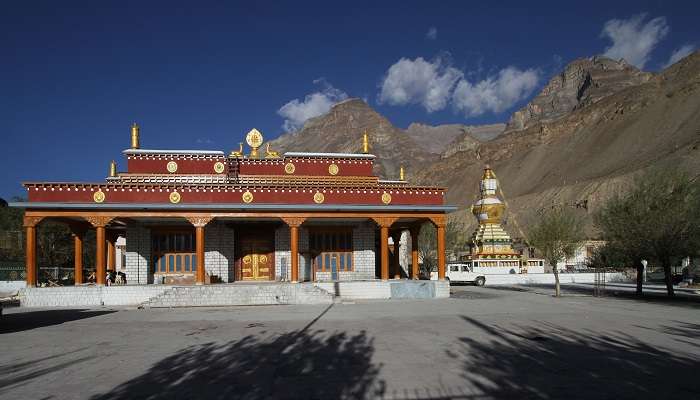
Situated at about 50 kilometres from Dhankar, Tabo Monastery happens to be one of the oldest religious destinations in the Spiti Valley. Established in 996 A.D, it is popularly called as “Ajanta of Himalayas” because of its ornate paintings and sculptures. Monastery also comprises several temples, stupas and monks’ living spaces representing Tibetan Buddhist cultural values. It is a must-visit place for history lovers and people who seek spirituality and relaxation combined with stunning views of the Himalayan mountains and awesome architecture ornamented with countless works of art.
Location: 39VM+C56, Tabo, Dhar Gangchhumi, Himachal Pradesh 172113
Distance from Dhankar Fort: 31.3 KM
2. Pin Valley National Park:
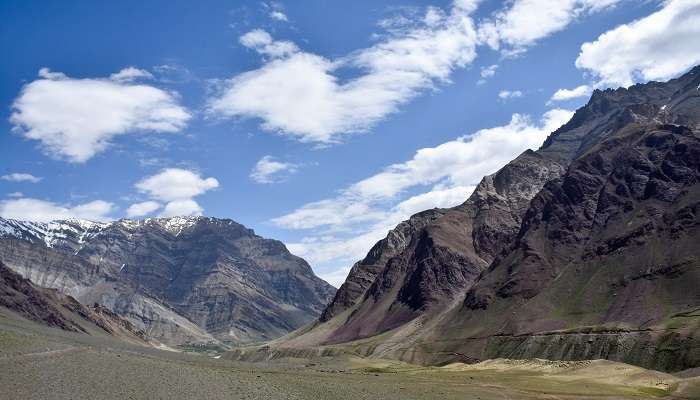
Pin Valley National Park, located approximately 55 km from Dhankar, is a paradise for wildlife lovers. The park hosts the snow leopard, Siberian ibex, and several avian species, making it one of the most popular bio-diverse regions. Rich vegetation, steep slopes, and the prevalence of high mountains make the region suitable for lovers of natural beauty. Hiking in the park provides an opportunity to explore the park’s unspoilt natural scenery and enjoy the quiet, serene environment free from human interference.
Location: XVXJ+RX4, Kaza Valley, Himachal Pradesh 172117
Distance from Dhankar Fort: 32.7 KM
Suggested Read: Chicham
3. Key Monastery
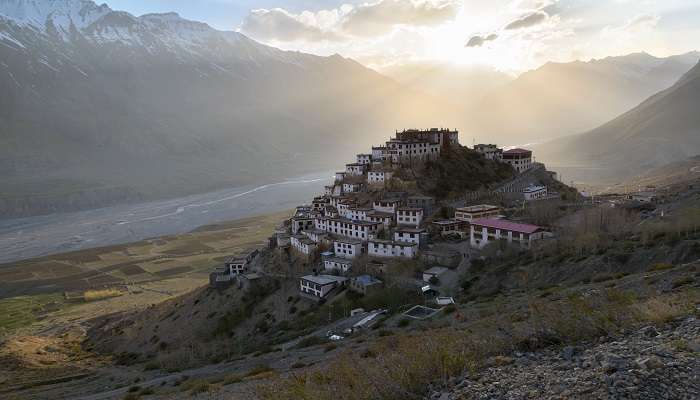
Key Monastery, the largest one in Spiti Valley, can be found about 35 km from Dhankar. Located on a hilltop overlooking the Spiti River, the monastery is famous with rich architecture, manuscripts, and festivals. The complex comprises various prayer halls, separate rooms for the monks, and a variety of thangka paintings of considerable value. Situated on a mountain terrace, the monastery offers splendid vistas of the neighboring valley, which has attracted numerous visitors. Apart from being a religious shrine, Key Monastery also has a lot to do with the Buddhist heritage of the area.
Location: 72X6+4QM, Key, Pinjoor, Himachal Pradesh 172114
Distance from Dhankar Fort: 47.4KM
4. Chandratal Lake
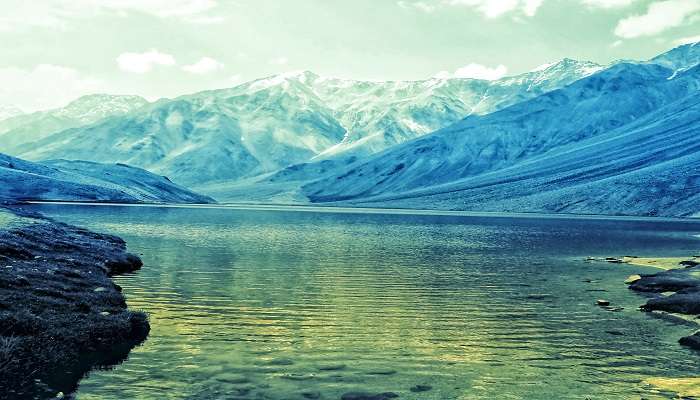
Chandratal Lake also known as the Moon Lake is located about 75 kilometers away from Dhankar. This is a crescent-shaped lake with vibrant blue waters and an equally beautiful backdrop. Located at about 4,300 meters above sea level, Chandratal lake is a serene and somewhat mystical place. It is also famous for camping, trekking, and photography and is often visited by adventurers and nature lovers. The night time provides clear sky making it the perfect time to see the stars, hence the Chandratal Lake in the heart of Himalayan mountain range enhances your mesmerizing trip.
Location: Western Himalaya, Lahaul Valley, Himachal Pradesh
Distance from Dhankar Fort: 130.5 KM
Suggested Read: Spiti Valley Trek
Tips And Suggestions
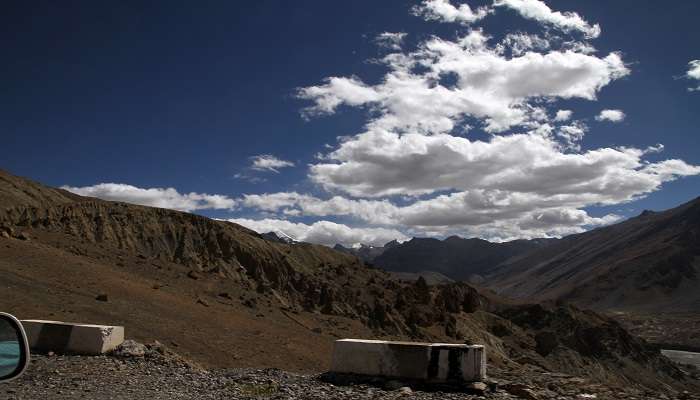
Acclimatization:
Dhankar is located at an elevation of approximately 3,894 meters above sea level. To reduce instances of altitude sickness, adequate time must be taken for the body to adjust to the new atmosphere. It is recommended to acclimatize for a couple of days in Kaza or some other lower-altitude region before going to Dhankar.
Dress in Layers:
The temperature in Spiti Valley can also vary greatly during the day and night. It is very cold, especially from December to February. The weather is very unpredictable so one should dress in layers, take a jacket because it could still be cold.
Carry Essentials:
Take necessities like sun lotion, lip cream, shades, and a cap in case the climate is blazing as you reach higher regions. Also, carry enough water and food as there is no appropriate food joint around the area of Dhankar Fort.
Respect Local Culture:
The area of Spiti is ethnically quite diverse. Adhere to cultural practices, particularly when visiting monasteries and interacting with the local people. It is recommended that you always seek the people’s prior permission before taking any shots.
How To Reach

By Air:
The nearest Airport is at Bhuntar, Kullu-Manali which is about 245 Kms away from Dhankar Fort. One can easily hire a taxi or get a bus from the airport directly to Kaza which is the administrative center of the Spiti Valley. Dhankar can then be reached from Kaza.
By Road:
Dhankar is connected by a well maintained motorable road that is around 35 kilometers from Kaza. The journey takes roughly two hours by car. You can also use the buses and shared taxi to cover this distance. They are cheaper as compared to the private taxis. The fort is located at the end of the parking area; it is accessible by a short steep trail along the wall which is like a natural pathway.
By Rail:
The nearest rail station is at Shimla which is about a distance of 445 Kms from here. On reaching Shimla, you may take a bus or hire a taxi to cover the distance to Kaza and then directly to Dhankar.
Further Read: Places To Visit In Kaza
Considering its historical background, beautiful scenery, and cultural importance, Dhankar Fort is a place every traveller would like to visit. Even though the building of the fort may stand in disarray today, the histories it can tell and the views it boasts are eternal. Irrespective of whether you are inclined to history, are an adrenaline junkie or you simply want to cocoon yourself in the tranquility of the hills, Dhankar Fort is going to sweep you off your feet.So, the next time you plan to go on a trip to Himachal Pradesh or take up hiking as a weekend hobby, do not forget to explore the beauty of Dhankar Fort. Let the fort walls speak to you when you are standing in the ruins, looking at the mesmerizing territory of Spiti Valley.
For our editorial codes of conduct and copyright disclaimer, please click here.
Cover Image Credit:Deepank Ranka for wikimedia commons
Frequently Asked Questions About Dhankar Fort
What is the historical significance of Dhankar Fort?
Dhankar Fort is as old as 12 century and was the capital of the Spiti Valley. War was a common occurrence during that time and so, it was designed to sit on a cliff to facilitate the watching out for invasions while at the same time providing a safe refuge to people from the entire valley in case of such instances.
How can I reach Dhankar Fort?
Dhankar fort can be approached by road transport from Kaza the nearest town about 35KMs from the fort. You can take a taxi or bus till Kaza and then start, or you can also take a bus or taxi directly to Dhankar. The next airport is Kullu-Manali airport at Bhuntar, which is about two hundred and forty-five kilometers away from Dhankar.
What are the best times to visit Dhankar Fort?
The appropriate time to visit Dhankar Fort is during May-September, since the climate is good for travelling and there are no road blockages. The weather is severe during winter, especially between October and April when snow accumulation makes it almost impossible to access the area while during monsoon season from July to September occasional landslides may take place.
What can I do at Dhankar Fort?
The fort ruins can be visited, photography is possible with the magnificent views over Spiti valley, there is an ancient Dhankar Monastery, there are opportunities for hiking to Dhankar Lake, and one will also have a possibility of bird watching as well as meditate in a calm atmosphere.
Are there any other attractions near Dhankar Fort?
Other nearby places of interest include the Tabo Monastery which features splendid murals and statues, the Pin Valley National Park famous for wildlife and the Key Monastery as it stands as the largest monastery in Spiti offering a magnificent architectural view and scenic view of the landscape.
People Also Read:
Singalila National Park Manas National Park Jim Corbett National Park

Innovative Content Writer Focused on Producing High quality, Original Content that drives traffic and engages readers. Experienced in Content strategy and analytics to measure content performance using tools such as SQL, Power BI, Excel.











